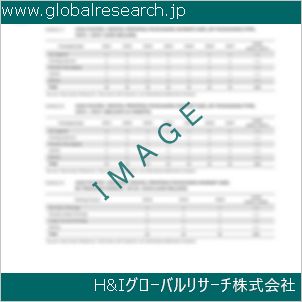1 Cell Buffer Solutions Market Overview
1.1 Product Definition
1.2 Cell Buffer Solutions Segment by Type
1.2.1 Global Cell Buffer Solutions Market Value Growth Rate Analysis by Type 2022 VS 2029
1.2.2 Acidic Buffer Solutions
1.2.3 Alkaline Buffer Solutions
1.3 Cell Buffer Solutions Segment by Application
1.3.1 Global Cell Buffer Solutions Market Value Growth Rate Analysis by Application: 2022 VS 2029
1.3.2 Scientific Research
1.3.3 Industrial Production
1.4 Global Market Growth Prospects
1.4.1 Global Cell Buffer Solutions Production Value Estimates and Forecasts (2018-2029)
1.4.2 Global Cell Buffer Solutions Production Capacity Estimates and Forecasts (2018-2029)
1.4.3 Global Cell Buffer Solutions Production Estimates and Forecasts (2018-2029)
1.4.4 Global Cell Buffer Solutions Market Average Price Estimates and Forecasts (2018-2029)
1.5 Assumptions and Limitations
2 Market Competition by Manufacturers
2.1 Global Cell Buffer Solutions Production Market Share by Manufacturers (2018-2023)
2.2 Global Cell Buffer Solutions Production Value Market Share by Manufacturers (2018-2023)
2.3 Global Key Players of Cell Buffer Solutions, Industry Ranking, 2021 VS 2022 VS 2023
2.4 Global Cell Buffer Solutions Market Share by Company Type (Tier 1, Tier 2 and Tier 3)
2.5 Global Cell Buffer Solutions Average Price by Manufacturers (2018-2023)
2.6 Global Key Manufacturers of Cell Buffer Solutions, Manufacturing Base Distribution and Headquarters
2.7 Global Key Manufacturers of Cell Buffer Solutions, Product Offered and Application
2.8 Global Key Manufacturers of Cell Buffer Solutions, Date of Enter into This Industry
2.9 Cell Buffer Solutions Market Competitive Situation and Trends
2.9.1 Cell Buffer Solutions Market Concentration Rate
2.9.2 Global 5 and 10 Largest Cell Buffer Solutions Players Market Share by Revenue
2.10 Mergers & Acquisitions, Expansion
3 Cell Buffer Solutions Production by Region
3.1 Global Cell Buffer Solutions Production Value Estimates and Forecasts by Region: 2018 VS 2022 VS 2029
3.2 Global Cell Buffer Solutions Production Value by Region (2018-2029)
3.2.1 Global Cell Buffer Solutions Production Value Market Share by Region (2018-2023)
3.2.2 Global Forecasted Production Value of Cell Buffer Solutions by Region (2024-2029)
3.3 Global Cell Buffer Solutions Production Estimates and Forecasts by Region: 2018 VS 2022 VS 2029
3.4 Global Cell Buffer Solutions Production by Region (2018-2029)
3.4.1 Global Cell Buffer Solutions Production Market Share by Region (2018-2023)
3.4.2 Global Forecasted Production of Cell Buffer Solutions by Region (2024-2029)
3.5 Global Cell Buffer Solutions Market Price Analysis by Region (2018-2023)
3.6 Global Cell Buffer Solutions Production and Value, Year-over-Year Growth
3.6.1 North America Cell Buffer Solutions Production Value Estimates and Forecasts (2018-2029)
3.6.2 Europe Cell Buffer Solutions Production Value Estimates and Forecasts (2018-2029)
3.6.3 China Cell Buffer Solutions Production Value Estimates and Forecasts (2018-2029)
3.6.4 Japan Cell Buffer Solutions Production Value Estimates and Forecasts (2018-2029)
4 Cell Buffer Solutions Consumption by Region
4.1 Global Cell Buffer Solutions Consumption Estimates and Forecasts by Region: 2018 VS 2022 VS 2029
4.2 Global Cell Buffer Solutions Consumption by Region (2018-2029)
4.2.1 Global Cell Buffer Solutions Consumption by Region (2018-2023)
4.2.2 Global Cell Buffer Solutions Forecasted Consumption by Region (2024-2029)
4.3 North America
4.3.1 North America Cell Buffer Solutions Consumption Growth Rate by Country: 2018 VS 2022 VS 2029
4.3.2 North America Cell Buffer Solutions Consumption by Country (2018-2029)
4.3.3 United States
4.3.4 Canada
4.4 Europe
4.4.1 Europe Cell Buffer Solutions Consumption Growth Rate by Country: 2018 VS 2022 VS 2029
4.4.2 Europe Cell Buffer Solutions Consumption by Country (2018-2029)
4.4.3 Germany
4.4.4 France
4.4.5 U.K.
4.4.6 Italy
4.4.7 Russia
4.5 Asia Pacific
4.5.1 Asia Pacific Cell Buffer Solutions Consumption Growth Rate by Region: 2018 VS 2022 VS 2029
4.5.2 Asia Pacific Cell Buffer Solutions Consumption by Region (2018-2029)
4.5.3 China
4.5.4 Japan
4.5.5 South Korea
4.5.6 China Taiwan
4.5.7 Southeast Asia
4.5.8 India
4.6 Latin America, Middle East & Africa
4.6.1 Latin America, Middle East & Africa Cell Buffer Solutions Consumption Growth Rate by Country: 2018 VS 2022 VS 2029
4.6.2 Latin America, Middle East & Africa Cell Buffer Solutions Consumption by Country (2018-2029)
4.6.3 Mexico
4.6.4 Brazil
4.6.5 Turkey
5 Segment by Type
5.1 Global Cell Buffer Solutions Production by Type (2018-2029)
5.1.1 Global Cell Buffer Solutions Production by Type (2018-2023)
5.1.2 Global Cell Buffer Solutions Production by Type (2024-2029)
5.1.3 Global Cell Buffer Solutions Production Market Share by Type (2018-2029)
5.2 Global Cell Buffer Solutions Production Value by Type (2018-2029)
5.2.1 Global Cell Buffer Solutions Production Value by Type (2018-2023)
5.2.2 Global Cell Buffer Solutions Production Value by Type (2024-2029)
5.2.3 Global Cell Buffer Solutions Production Value Market Share by Type (2018-2029)
5.3 Global Cell Buffer Solutions Price by Type (2018-2029)
6 Segment by Application
6.1 Global Cell Buffer Solutions Production by Application (2018-2029)
6.1.1 Global Cell Buffer Solutions Production by Application (2018-2023)
6.1.2 Global Cell Buffer Solutions Production by Application (2024-2029)
6.1.3 Global Cell Buffer Solutions Production Market Share by Application (2018-2029)
6.2 Global Cell Buffer Solutions Production Value by Application (2018-2029)
6.2.1 Global Cell Buffer Solutions Production Value by Application (2018-2023)
6.2.2 Global Cell Buffer Solutions Production Value by Application (2024-2029)
6.2.3 Global Cell Buffer Solutions Production Value Market Share by Application (2018-2029)
6.3 Global Cell Buffer Solutions Price by Application (2018-2029)
7 Key Companies Profiled
7.1 Thermo Fisher
7.1.1 Thermo Fisher Cell Buffer Solutions Corporation Information
7.1.2 Thermo Fisher Cell Buffer Solutions Product Portfolio
7.1.3 Thermo Fisher Cell Buffer Solutions Production, Value, Price and Gross Margin (2018-2023)
7.1.4 Thermo Fisher Main Business and Markets Served
7.1.5 Thermo Fisher Recent Developments/Updates
7.2 Merck
7.2.1 Merck Cell Buffer Solutions Corporation Information
7.2.2 Merck Cell Buffer Solutions Product Portfolio
7.2.3 Merck Cell Buffer Solutions Production, Value, Price and Gross Margin (2018-2023)
7.2.4 Merck Main Business and Markets Served
7.2.5 Merck Recent Developments/Updates
7.3 Cytiva
7.3.1 Cytiva Cell Buffer Solutions Corporation Information
7.3.2 Cytiva Cell Buffer Solutions Product Portfolio
7.3.3 Cytiva Cell Buffer Solutions Production, Value, Price and Gross Margin (2018-2023)
7.3.4 Cytiva Main Business and Markets Served
7.3.5 Cytiva Recent Developments/Updates
7.4 Biowest
7.4.1 Biowest Cell Buffer Solutions Corporation Information
7.4.2 Biowest Cell Buffer Solutions Product Portfolio
7.4.3 Biowest Cell Buffer Solutions Production, Value, Price and Gross Margin (2018-2023)
7.4.4 Biowest Main Business and Markets Served
7.4.5 Biowest Recent Developments/Updates
7.5 Sartorius
7.5.1 Sartorius Cell Buffer Solutions Corporation Information
7.5.2 Sartorius Cell Buffer Solutions Product Portfolio
7.5.3 Sartorius Cell Buffer Solutions Production, Value, Price and Gross Margin (2018-2023)
7.5.4 Sartorius Main Business and Markets Served
7.5.5 Sartorius Recent Developments/Updates
7.6 VWR
7.6.1 VWR Cell Buffer Solutions Corporation Information
7.6.2 VWR Cell Buffer Solutions Product Portfolio
7.6.3 VWR Cell Buffer Solutions Production, Value, Price and Gross Margin (2018-2023)
7.6.4 VWR Main Business and Markets Served
7.6.5 VWR Recent Developments/Updates
7.7 R&D Systems
7.7.1 R&D Systems Cell Buffer Solutions Corporation Information
7.7.2 R&D Systems Cell Buffer Solutions Product Portfolio
7.7.3 R&D Systems Cell Buffer Solutions Production, Value, Price and Gross Margin (2018-2023)
7.7.4 R&D Systems Main Business and Markets Served
7.7.5 R&D Systems Recent Developments/Updates
7.8 RMBIO
7.8.1 RMBIO Cell Buffer Solutions Corporation Information
7.8.2 RMBIO Cell Buffer Solutions Product Portfolio
7.8.3 RMBIO Cell Buffer Solutions Production, Value, Price and Gross Margin (2018-2023)
7.8.4 RMBIO Main Business and Markets Served
7.7.5 RMBIO Recent Developments/Updates
7.9 PAN-Biotech
7.9.1 PAN-Biotech Cell Buffer Solutions Corporation Information
7.9.2 PAN-Biotech Cell Buffer Solutions Product Portfolio
7.9.3 PAN-Biotech Cell Buffer Solutions Production, Value, Price and Gross Margin (2018-2023)
7.9.4 PAN-Biotech Main Business and Markets Served
7.9.5 PAN-Biotech Recent Developments/Updates
7.10 ITW Reagents
7.10.1 ITW Reagents Cell Buffer Solutions Corporation Information
7.10.2 ITW Reagents Cell Buffer Solutions Product Portfolio
7.10.3 ITW Reagents Cell Buffer Solutions Production, Value, Price and Gross Margin (2018-2023)
7.10.4 ITW Reagents Main Business and Markets Served
7.10.5 ITW Reagents Recent Developments/Updates
8 Industry Chain and Sales Channels Analysis
8.1 Cell Buffer Solutions Industry Chain Analysis
8.2 Cell Buffer Solutions Key Raw Materials
8.2.1 Key Raw Materials
8.2.2 Raw Materials Key Suppliers
8.3 Cell Buffer Solutions Production Mode & Process
8.4 Cell Buffer Solutions Sales and Marketing
8.4.1 Cell Buffer Solutions Sales Channels
8.4.2 Cell Buffer Solutions Distributors
8.5 Cell Buffer Solutions Customers
9 Cell Buffer Solutions Market Dynamics
9.1 Cell Buffer Solutions Industry Trends
9.2 Cell Buffer Solutions Market Drivers
9.3 Cell Buffer Solutions Market Challenges
9.4 Cell Buffer Solutions Market Restraints
10 Research Finding and Conclusion
11 Methodology and Data Source
11.1 Methodology/Research Approach
11.1.1 Research Programs/Design
11.1.2 Market Size Estimation
11.1.3 Market Breakdown and Data Triangulation
11.2 Data Source
11.2.1 Secondary Sources
11.2.2 Primary Sources
11.3 Author List
11.4 Disclaimer
| ※参考情報 細胞緩衝液(Cell Buffer Solutions)は、生物学的および生化学的な実験において非常に重要な役割を果たす溶液です。これらの溶液は、主に細胞や組織の培養、酵素反応、分析、タンパク質の精製など、多岐にわたる用途に使用されます。以下では、細胞緩衝液の定義、特徴、種類、用途、関連技術について詳しく説明いたします。 細胞緩衝液の定義として、主にpHを一定に保つために設計された aqueous solution のことを指します。生物体内では、多くの生理的過程が特定のpH範囲内で最適に機能することが求められます。例えば、細胞内液のpHは通常7.2から7.4の範囲にあります。このようなpHを保つために、緩衝液は酸や塩基を中和する能力を持っています。つまり、外部からの酸や塩基の影響を受けても、pHの変動を抑えることができます。 細胞緩衝液の特徴には、まず環境に敏感であることが挙げられます。これらの溶液は、温度や濃度、イオン強度などの環境条件に応じて中和能力が変わることがあります。また、緩衝能は特定のpH範囲に最も効果を発揮するため、使用する場面に応じて最適な緩衝液の選択が必要です。このため、研究者は様々な種類の緩衝液を使い分けることで、実験結果の一貫性を保つことが求められます。 細胞緩衝液には多くの種類があります。最も一般的に使用されるものの一つは、リン酸緩衝液(PBS)です。この緩衝液は、主にリン酸とナトリウム塩から成り、細胞培養や抗体の希釈などで広く利用されています。PBSは生理的条件に近いpHを維持する能力を持っていることから、実験系に適した選択肢とされています。 次に、Tris緩衝液も非常に重要な緩衝液の一つです。Tris(トリス)は、通常、pH 7.0から9.0の範囲で使用され、多くの分子生物学的アプリケーションで利用されます。特に、DNAやRNAの抽出、酵素反応、ゲル電気泳動などで使用されます。Tris緩衝液は、安定性が高く、比較的簡単に調製できるため、研究室でも一般的に使われています。 さらに、Hepes緩衝液も広く使用されており、主に細胞培養においてpHを安定化させるために用いられます。Hepesは、人物の生理的条件に近いpH(通常7.2から7.6)で動作するため、細胞の生存率を高めることが知られています。また、Hepesは温度変化に対するバッファー能力を持ち、反応条件の変化にも適応しやすいという特性があります。 細胞緩衝液の用途は非常に多岐にわたります。まず、細胞の培養においては、細胞が適切な環境で成長できるようにするために不可欠です。細胞培養は多くの生物学的研究の基盤となり、その過程で緩衝液が果たす役割は非常に重要です。また、酵素反応においては、酵素の最適活性を維持するためにpHが重要であるため、緩衝液は欠かせません。特に、酵素反応に必要な基質や生成物がpHに敏感である場合、緩衝液の選択が実験の成功に大きく寄与します。 さらに、細胞緩衝液は、タンパク質や核酸の精製、分析、および保存においても重要です。例えば、タンパク質を特定の条件で純化する際には、目的のタンパク質が変性しないようにpHを厳密に管理する必要があります。このような用途では、採取元の生物材料の性質に応じたカスタマイズされた緩衝液が必要とされることが多いです。 細胞緩衝液には関連技術も多岐にわたります。例えば、緩衝液の製造過程において、純度や成分の標準化を行う技術が求められます。また、細胞培養における無菌操作や代謝産物の分析技術も、細胞緩衝液を活用した重要な技術です。さらに、新しい細胞培養技術やベクター設計、遺伝子編集技術など、現代のライフサイエンスの進歩に伴い、緩衝液の役割はさらに多様化しています。 総じて、細胞緩衝液は生物学的な実験や応用における基盤であり、その理解と選択は成功へ導くために重要です。細胞緩衝液の特性や用途を適切に把握することで、今後の研究や技術開発においても非常に役立つでしょう。 |
❖ 免責事項 ❖
http://www.globalresearch.jp/disclaimer

-gr.jpg)










